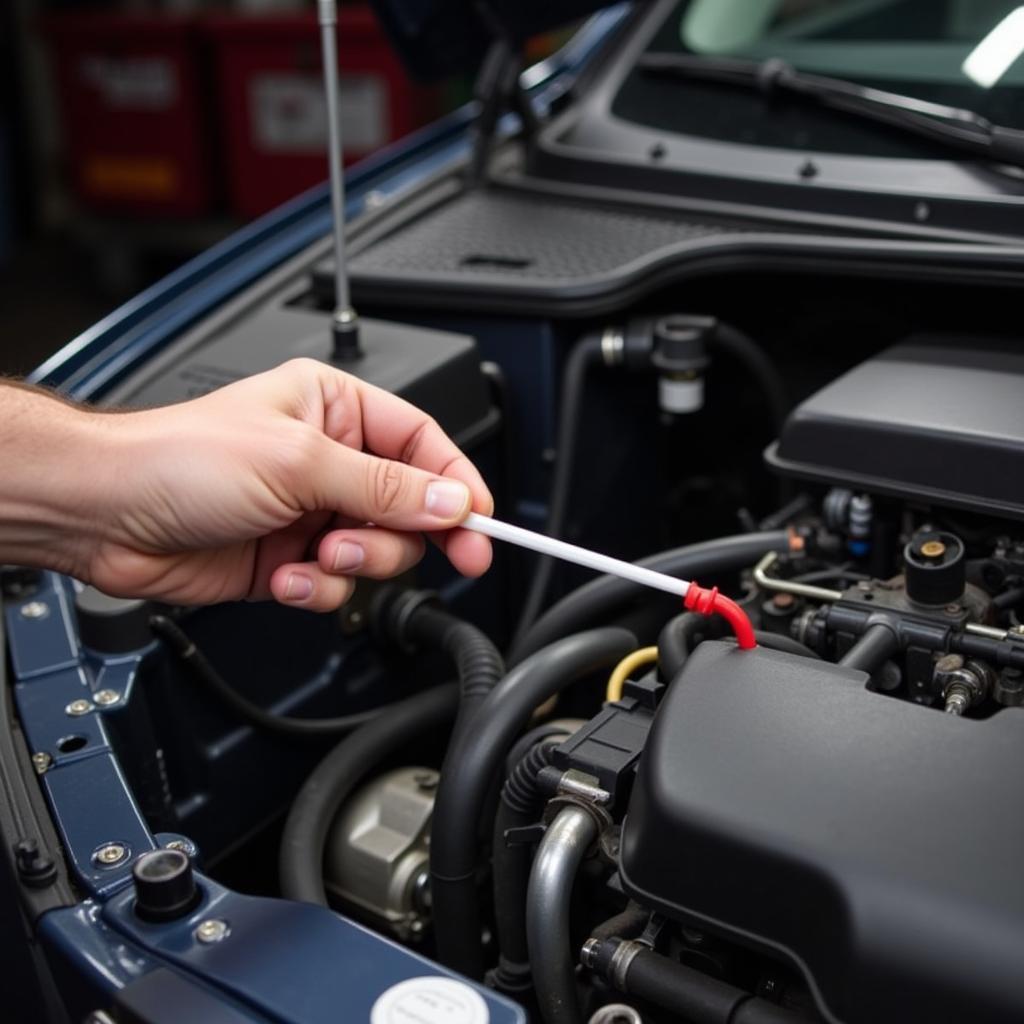A brake warning light on your dashboard is a clear signal that something is wrong with your braking system and requires immediate attention. Ignoring it could lead to brake failure, putting you and others at risk. This guide will help you understand the different types of brake warnings, diagnose the potential causes, and outline the necessary steps to take.
Deciphering Your Dashboard: Types of Brake Warning Lights
There are several brake-related warning lights you might encounter on your dashboard, each conveying a specific message:
- Brake System Warning Light: This general warning, often symbolized by the word “BRAKE” or an exclamation mark within a circle, can indicate various issues like low brake fluid, a problem with the hydraulic system, or an engaged parking brake.
- Anti-lock Braking System (ABS) Light: Indicated by the letters “ABS” within a circle, this light means your ABS system, designed to prevent wheel lock-up during braking, is malfunctioning. While you can still brake normally, the ABS functionality will be disabled.
- Electronic Stability Control (ESC) Light: Often represented by a car with skid marks, this light signals a problem with your ESC system, responsible for maintaining vehicle stability during maneuvers. Like the ABS light, it indicates a loss of this specific safety feature.
- Parking Brake Warning Light: This light, usually symbolized by a “P” within a circle, signifies that your parking brake is engaged. If illuminated while driving, it’s a reminder to disengage the brake or could indicate a fault in the system.
 Car dashboard with multiple brake warning lights illuminated
Car dashboard with multiple brake warning lights illuminated
Common Culprits: What Causes Brake Warning Lights to Illuminate?
Several factors can trigger your brake warning lights:
- Low Brake Fluid: This is one of the most common causes. Brake fluid transmits force from the brake pedal to the wheels, and a leak or low fluid level can significantly compromise braking performance.
- Worn Brake Pads: Brake pads are designed to wear down over time. Excessively worn pads can trigger the brake warning light, signaling the need for replacement.
- Faulty ABS Sensors: ABS sensors monitor wheel speed and relay information to the ABS control module. A malfunctioning sensor can disrupt the system, illuminating the ABS warning light.
- Hydraulic System Problems: Leaks or air in the brake lines, a faulty master cylinder, or other issues within the hydraulic system can lead to brake warning lights and reduced braking efficiency.
- Electrical Issues: Faulty wiring, a malfunctioning brake light switch, or issues with the vehicle’s electrical system can also trigger brake warning lights.
 Mechanic checking brake fluid level in a vehicle
Mechanic checking brake fluid level in a vehicle
Taking Action: Steps to Address a Brake Warning Light
A brake warning light is a serious matter that should never be ignored. Here’s what to do:
- Pull Over Safely: As soon as it is safe, pull over to the side of the road. Continuing to drive with a compromised braking system is incredibly dangerous.
- Check Your Parking Brake: Ensure your parking brake is fully disengaged. If the light remains on, it indicates a problem beyond the parking brake itself.
- Inspect Brake Fluid: If possible, carefully check your brake fluid level. If it’s low, adding more might temporarily solve the issue, but it’s crucial to have the system inspected for leaks.
- Avoid Driving: If the warning light persists or you suspect a serious issue, avoid driving and have your vehicle towed to a trusted mechanic or dealership.
 Tow truck transporting a car with brake problems
Tow truck transporting a car with brake problems
Remote Diagnostics and Software Solutions: The Future of Car Repair
In today’s digitally connected world, remote diagnostics and software solutions are transforming the automotive repair industry. With advancements in technology, qualified technicians can now remotely diagnose brake system issues and, in some cases, even implement software-based fixes, saving you time and potentially costly repairs.
Expert Insight:
“Remote diagnostics are revolutionizing the way we approach car repair. By accessing vehicle data remotely, we can quickly identify the root cause of a problem, like a faulty ABS sensor, and provide efficient solutions.” – John Miller, Senior Automotive Diagnostic Technician
FAQs: Addressing Common Concerns about Brake Warning Lights
1. Can I drive a short distance with the brake warning light on?
It’s strongly advised against driving with a brake warning light illuminated. Even a short distance poses a significant risk.
2. How much does it cost to fix a brake warning light issue?
The cost varies widely depending on the underlying cause. A simple brake pad replacement is far less expensive than repairing a faulty ABS control module.
3. How often should I get my brakes checked?
It’s recommended to have your brakes inspected at least once a year or every 12,000 miles, or more frequently if you notice any changes in brake performance.
Don’t Ignore the Warning: Prioritize Your Safety
A brake warning light is a serious indicator that should never be ignored. By understanding the different types of warnings, potential causes, and taking prompt action, you can ensure your safety and those around you. Remember, regular maintenance and timely repairs are crucial for optimal brake system performance.


